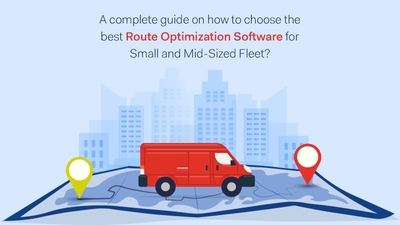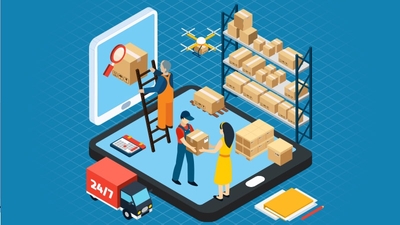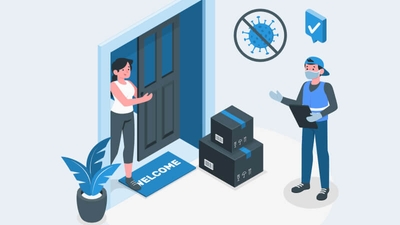Over a decade or so, there has been a paradigm shift in the retail sector as all the retail companies have quickly moved from the brick-and-mortar stores to eCommerce channels. To keep their business relevant in the age of the internet, they all have decided to go online. That’s why it won’t be wrong to say that the internet has transformed the traditional retail business into eCommerce.

But it’s not only the retail businesses that have changed; the shopping habits of the customers have also undergone immense change over the years.
These below stats show us how:
- 66% of millennial shoppers say that they want the eCommerce companies to provide the 1-hour delivery option in metropolitan cities.
- 29% of the shoppers have changed the delivery time and location of their package. Furthermore, 50% would like to opt for it if that option is available.
- 27% of the shoppers in the US have canceled their order as there was no same-day delivery option available.
- 90% of the shoppers track the delivery status of their package and want their delivery to fit seamlessly with their schedule.
Earlier, a waiting period of 5-7 days was considered normal; however, today if any company takes 5-7 days to deliver the shipment, then it’s doomed to decline as there are many competitors who are already delivering packages in the matter of a few hours.
The phenomenon of same-day delivery and drone deliveries have redefined the customer experience and convenience. Due to which various eCommerce companies are finding different ways to stay in this cut-throat competition.
The last mile delivery for eCommerce has also changed over the time. Today, in typical home delivery, the package is housed in a suburban warehouse which is common for both store fulfillment and eCommerce.
After that, the product is shipped either by air or by ground transportation. Nowadays, many companies are also using a secondary location called urban “hub” which enables faster delivery.
The urban warehouse acts as a supplement to the supply chain as it improves the efficiency of the last mile delivery since it’s in proximity to the high volumes of customers.
Prior to the disruption caused by eCommerce, the suburban warehouse strategy served its purpose sufficiently. However, as the customer’s demand exceeded, this strategy was no longer sufficient.
To meet the growing demands of the customers, retailers needed to come up with a solution that can solve the last mile delivery problem in an efficient way.
But to understand that we first we need to know what exactly last mile delivery problems are?
What is the last mile delivery problem?
To understand this, we need to first understand what last mile delivery means. Last mile delivery is the last leg of the delivery process which starts from the distribution center or hub to the end user’s doorsteps. The last mile delivery usually ranges from a few blocks to 50 or even 100 miles.

So, all the loopholes associated with this final leg are called last mile delivery problems. The main objective of the last mile delivery is to deliver the package to the customer as soon as possible. So, all the elements which cause hindrance and make this process inefficient are the last mile delivery problem.
Let’s understand these problems in detail.
Last mile delivery challenges in eCommerce logistics
High Cost
One of the major reasons why last mile delivery is considered a vital portion of the eCommerce logistics is that its constituents around 28% of the total delivery costs. In addition to that, the expectation of same-day deliveries from the consumers puts a greater strain on the budget.
To make things worse the eCommerce companies also have to also deal with the inconsistent demands, like surge in the purchase volumes during the holiday season.
Read More: Cut down your last-mile delivery cost to increase your profit margins.
Lack of Transparency
Transparency has become an important element for any business. The consumers want to know where exactly their package is and when will it reach them. In response to this, many businesses especially the 3PLs began generating the tracking codes. These tracking codes allowed consumers to gain some kind of visibility over their delivery. However, these weren’t enough for modern consumers who are habituated with on-demand services.
They demand full access to the real-time visibility of their delivery. In simple words, they want to track the entire last mile delivery phase.
Lower Efficiency
Customers have always been the main driving force for pushing increased efficiency in eCommerce logistics. Many other challenges accompanied by the need for higher efficiency mean one thing – faster deliveries.
The on-demand business model has penetrated almost all the industry ensuring lightning speed delivery of services and products, and online retail in on the same path.
Increased efficiency can be achieved throughout the supply chain with the help of last mile delivery solutions. Technology is a key aspect when it comes to the last mile delivery and same-day delivery.
Technology plays a huge role in ensuring the automatic dispatching to the right person, at the right time, in the right area. Technology can significantly help in increasing the overall efficiency and subsequently decreasing the total time of the delivery.
Friction
A frictionless delivery is a boon for any eCommerce company as it guarantees high efficiency and larger cuts in costs. Dealing with customer inquiries about their delivery is one of the biggest hindrances that cause friction in the last mile delivery. These inquiries involve various things as to how their package should be delivered. For example, it should be delivered only on weekday office hours or the delivery boy shouldn’t ring the doorbell.
To ensure a frictionless delivery process, you would require technology that facilitates seamless and open communication between the delivery person and the customer.
How does the last mile delivery solution help to overcome all the challenges?
To overcome all the above challenges, the eCommerce firms can take the help of a last mile delivery solution that optimizes this last leg completely with its advanced features. Let’s have a look at few of its advanced features and benefits below:
Real-time Delivery Tracking
With the help of robust retail delivery software, the customers can receive real-time updates about the movement of their shipment. The customer along with the store manager can track the en-route delivery of the shipment until it reaches the customer. With this feature, the store manager can actually control the last mile deliveries.
Similarly, it also enhances the customer satisfaction level as the customer gets to know exactly when and where their package would be delivered. The electronic proof of delivery is the next step of the tracking which makes invoicing transparent and hassle-free.
Read More: How Route Optimization Enhances Last Mile Delivery Operations.
Dynamic delivery route planning
The eCommerce and retail sector has always been troubled by the rerouting of deliveries due to last moment changes in the addresses done by the customers. However, with the help of last mile delivery software for eCommerce business, all these changes can be easily accommodated.
With the assistance of last mile logistics software, the companies can easily re-route their workforce as soon as they receive the update. This will avoid all the delays or downtimes caused by last moment changes in the schedule. Such dynamic and real-time schedule management can play a pivotal role in making your last mile delivery more efficient than ever.

Prioritize, schedule, and auto-allocate
The delivery volumes in recent years have seen a tremendous surge of around 20-30%. Due to which all the companies are expected to deliver shipments faster. With a robust last mile delivery logistics app powered by the artificial intelligence and machine learning technology, these companies can achieve the same by scheduling and prioritizing various orders based on several factors like:
- Preferred delivery time of customers
- Delivery preferences of stores
- Road restrictions and other factors
The eCommerce delivery software also auto-allocates these orders automatically. It considers various factors while allocating orders such as:
- Vehicle type
- Shipment specifics
- Required skill sets
After considering all the above factors, the solution allocates the shipment to the most suitable delivery person in the minimum possible time.
Customer engagement
The last mile delivery system also plays a critical role when it comes to customer engagement. With the real time delivery solution in place, the eCommerce and retail companies can allow their delivery persons and the customers to contact each other via chat and call. This feature helps in reducing the cases of missed deliveries by a great extent. It also helps in enhancing the overall customer satisfaction.
Future of last mile delivery logistics
Last mile is significant for both eCommerce and logistics businesses. To survive in the future, both of them must ensure to make their last mile delivery processes streamlined, efficient, and fast. And the best way to do that is by technological intervention. In the near future, you might see some of the below changes:
- Enhanced interfacing between the eCommerce and Logistics Company on one end and the customer on the other end.
- Introduction of the solution on various kinds of devices that have internet access. This will encourage the omnichannel approach and make communication faster.
- Better and timely collection of data which helps in a better understanding of customer behavior.
- Better storage and warehousing facilities for safer and faster movement of consignments.
Conclusion
Last mile presents an excellent opportunity for eCommerce companies to make their services faster, transparent, and efficient. Not only this, but by optimizing the last mile delivery, the eCommerce companies can also cut costs, build their brand value, and enhance the customer experience.
The last mile will always remain a critical part of all the eCommerce and logistics companies today and in the near future. So, if these companies want to succeed and overcome the challenges of market competition and unpredictability then they must leverage the innovative last mile delivery solutions.




